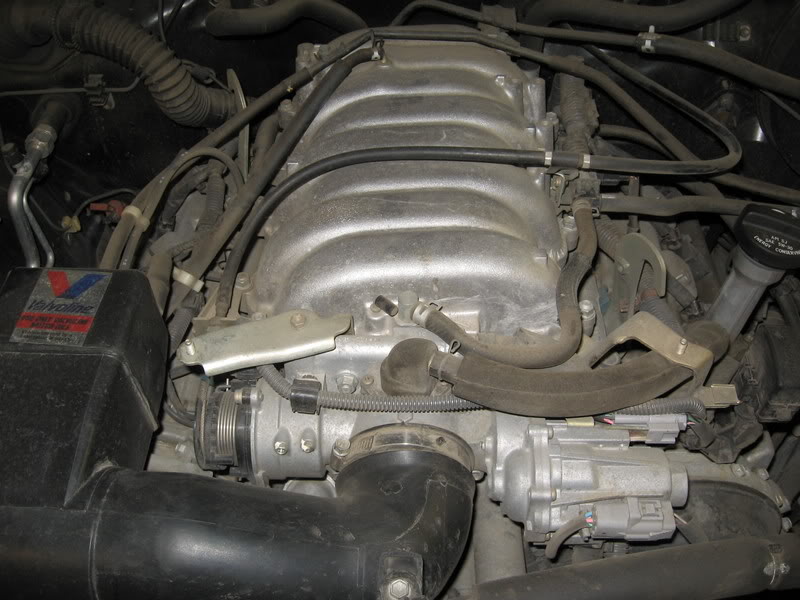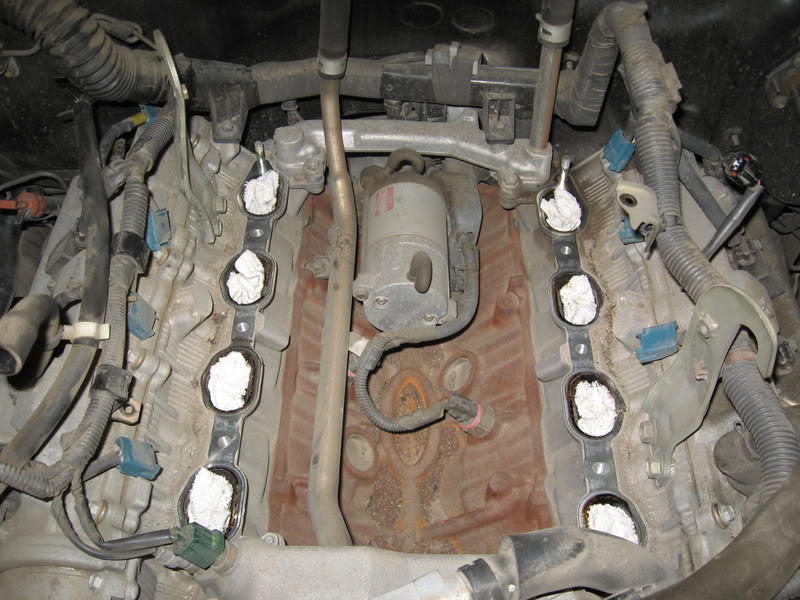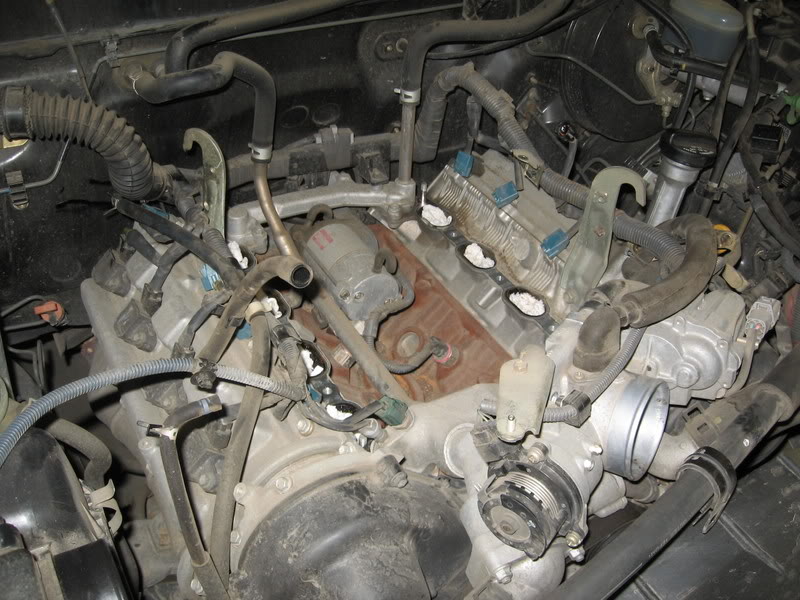Last edit by: IB Advertising
See related guides and technical advice from our community experts:
- Toyota Tundra How to Replace Starter<br>Step by step instructions for do-it-yourself repairs.
4.7 litre Tundra Starter
#1
4.7 litre Tundra Starter
Just a quick heads up to all the Tundra owners out there. Toyota makes a pretty good product and their starters are no exception. Most will not have any trouble with their starter, but for those who need to repair or replace their starter they will be dismayed to know that it is located under the intake manifold:

I was really ticked off when I found this out, but it really didn't turn out to be that big of a job. I had the manifold off in about 30 minutes. The upper and lower plenums come off together along with all the fuel rails and injectors. When you get it off the starter is staring you right in the face:

The FSM has you doing some unnecessary steps, the biggest of which is draining the cooling system. You don't need to do that at all, instaed remove the bolts holding the TB to the manifold and kind of let it lay off to the front. Then there is no need to crack to cooling system. In the next pic you can see the TB and attached heater hoses.

My starter had bad solenoid contacts, so I replaced those and put it all back together, but if you never want to do this job again it might be wise to put on a new factory starter.
All in all I think I spent 3 hours working on it from start to finish, and I stopped to eat dinner, so probably more like 2 1/2 hours. I spoke to a dealership mechanic that claimed to have the R&R starter procedure down to 30 minutes. That's pretty good!

I was really ticked off when I found this out, but it really didn't turn out to be that big of a job. I had the manifold off in about 30 minutes. The upper and lower plenums come off together along with all the fuel rails and injectors. When you get it off the starter is staring you right in the face:

The FSM has you doing some unnecessary steps, the biggest of which is draining the cooling system. You don't need to do that at all, instaed remove the bolts holding the TB to the manifold and kind of let it lay off to the front. Then there is no need to crack to cooling system. In the next pic you can see the TB and attached heater hoses.

My starter had bad solenoid contacts, so I replaced those and put it all back together, but if you never want to do this job again it might be wise to put on a new factory starter.
All in all I think I spent 3 hours working on it from start to finish, and I stopped to eat dinner, so probably more like 2 1/2 hours. I spoke to a dealership mechanic that claimed to have the R&R starter procedure down to 30 minutes. That's pretty good!
#3
The fuel line connects to the rail using a banjo style fitting. Look where the line attaches to the rail and you will see a top hat looking thing (might be a fuel reg?) the nut is directly under that thing. Can't remember the size, but it is about 24mm or so. The whole thing turns off to reveale the banjo fittings, be sure not to loose the two washers that go on either side of the banjo. Most recommend replacing them but I reused mine with no problems. In any case, be sure to check for fuel leaks when you get it running again.
Trending Topics
#11
#12
Very true sammy. It also helps that the starter isn't located right next to the hot exhaust manifold. I'm guessing that this is the basis for the logic that located it in the valley of the engine.
#14
My 2000 Tundra had this clicking problem and I decided to tackle it myself. The contacts were easy to replace once I finally got the started out. I wouldn't have done it if I hadn't found this forum with the great pictures. The throttle body was gummed up bad so I cleaned it while it was off. My truck cranks and runs like new. I'm sure I saved a ton of money, which is is short supply right now. Thanks zlathim!
#15
My 2000 Tundra had this clicking problem and I decided to tackle it myself. The contacts were easy to replace once I finally got the started out. I wouldn't have done it if I hadn't found this forum with the great pictures. The throttle body was gummed up bad so I cleaned it while it was off. My truck cranks and runs like new. I'm sure I saved a ton of money, which is is short supply right now. Thanks zlathim!
#18
Hello,
I'm trying to remove the intake manifold to replace the starter. I removed all the bolts and can lift the manifold, but can't seems to completley remove it. The fuel rail is in the way.
How or do I need to remove the rail from the manifold? or is there a better way to remove the manifold to get to the starter?
Also, is the knock sensor in this area? should I replace it too?
Thanks
I'm trying to remove the intake manifold to replace the starter. I removed all the bolts and can lift the manifold, but can't seems to completley remove it. The fuel rail is in the way.
How or do I need to remove the rail from the manifold? or is there a better way to remove the manifold to get to the starter?
Also, is the knock sensor in this area? should I replace it too?
Thanks
#19
I thought I'd post my experience with this. Just giving back a little, since I gained the confidence to do it after reading this post. Thanks to everyone who posted on this topic - especially Zlathim.
I have a 2000 4wd, auto, 4.7 - date of manufactur 7/99 150k miles
I found the starter on-line for $160 + $50 for two lower manifold gaskets.
I used the 2kw model, which my truck came equipped with. The 2kw model is stronger for cold weather.
I am not a mechanic! I'm just an everage Joe. There is a reputable independent shop three blocks from me that wanted $800 for this repair. I figured I had nothing to lose and I could always push it over there if need be. Here's some pointers and comments:
no special tools required. I did buy a $4 "pick" tool for grabbing bolts from tight spots.
I took thorough pictures at each step, for my own help in re-assembly, if needed
It appears the starter is easy to replace once the manifold is off. Not true - total pain to get the bolts and there is not enough extra wire on the starter to move it enough to re-wire it. I spent an hour or more just on the starter. just my experience, your mileage may very.
no, draining the cooling systems is not required. However, you'll notice a cooling pipe behind the starter - it is very much in the way. I chose to leave it in place, but it wouldn't be a bad idea to remove it.
It was mentioned there is a washer where the "top hat" fuel line connects. There are two actually, and the bottom one will fall off. Fortunately I found mine lying on the head two hours later. I only knew there were two from the 2 washer marks on the "top hat" and the fuel line fitting.
Ideally two people should lift off/on the manifold, awkward and heavy.
The fuel injectors can be twisted inward to protect them once wires are disconnected. I broke two wire housings. learn from my mistake. If you use two people for the step above, your chances of damaging anything will be minimal.
likely you will have to climb in and sit in the engine compartment. get some old blankets. I considered flattening the tires.
You can leave the fuel rails in place, just disconnect the two fuel lines.
It took me the better part of a day to do everything with plenty of breaks. Plan to be sore from all the contorted positions you will find yourself in.
I have a hard time believing a good Toyota mechanic could do this in a half hour. The book they quote labor from says 4 hours, but a good mechanic would probably spend 1-2 hours.
There has been some discussion on other boards as to what the problem actually is when it won't start and you know your battery is good. There's been talk of corroded wiring and a starter relay as the culprit. Mine started out only doing it once a month and got to the point of doing it almost everytime - and it got to that point very quickly. After the repair, I've done about 20 starts with no hint of trouble.
Good luck!
I have a 2000 4wd, auto, 4.7 - date of manufactur 7/99 150k miles
I found the starter on-line for $160 + $50 for two lower manifold gaskets.
I used the 2kw model, which my truck came equipped with. The 2kw model is stronger for cold weather.
I am not a mechanic! I'm just an everage Joe. There is a reputable independent shop three blocks from me that wanted $800 for this repair. I figured I had nothing to lose and I could always push it over there if need be. Here's some pointers and comments:
no special tools required. I did buy a $4 "pick" tool for grabbing bolts from tight spots.
I took thorough pictures at each step, for my own help in re-assembly, if needed
It appears the starter is easy to replace once the manifold is off. Not true - total pain to get the bolts and there is not enough extra wire on the starter to move it enough to re-wire it. I spent an hour or more just on the starter. just my experience, your mileage may very.
no, draining the cooling systems is not required. However, you'll notice a cooling pipe behind the starter - it is very much in the way. I chose to leave it in place, but it wouldn't be a bad idea to remove it.
It was mentioned there is a washer where the "top hat" fuel line connects. There are two actually, and the bottom one will fall off. Fortunately I found mine lying on the head two hours later. I only knew there were two from the 2 washer marks on the "top hat" and the fuel line fitting.
Ideally two people should lift off/on the manifold, awkward and heavy.
The fuel injectors can be twisted inward to protect them once wires are disconnected. I broke two wire housings. learn from my mistake. If you use two people for the step above, your chances of damaging anything will be minimal.
likely you will have to climb in and sit in the engine compartment. get some old blankets. I considered flattening the tires.
You can leave the fuel rails in place, just disconnect the two fuel lines.
It took me the better part of a day to do everything with plenty of breaks. Plan to be sore from all the contorted positions you will find yourself in.
I have a hard time believing a good Toyota mechanic could do this in a half hour. The book they quote labor from says 4 hours, but a good mechanic would probably spend 1-2 hours.
There has been some discussion on other boards as to what the problem actually is when it won't start and you know your battery is good. There's been talk of corroded wiring and a starter relay as the culprit. Mine started out only doing it once a month and got to the point of doing it almost everytime - and it got to that point very quickly. After the repair, I've done about 20 starts with no hint of trouble.
Good luck!
Last edited by artpreusser; 09-09-2010 at 07:34 PM.















